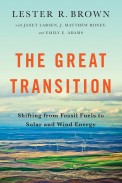Thursday, January 07, 2010
One of the unique qualities of the Earth Policy Institute is its interdisciplinary and global vision that often allows it to see trends that more specialized organizations cannot. Such research generates attention.
Lester Brown, EPI’s president and senior researcher, has a long history of seeing trends before others. When but a comparative youngster at the U.S. Department of Agriculture in the 1960s, he predicted an impending famine in India. The USDA team following India’s food production was skeptical. Orville Freeman, then Secretary of Agriculture, accepted Lester’s analysis and mounted the largest food relief effort in history, averting what would have been a great famine.
Sometimes Lester has been quite far ahead on his predictions. His book World Without Borders published in 1972 was the first to discuss the various implications of globalization—before the term was even in the lexicon.
He pioneered a redefinition of national security in his 1977 paper entitled “Redefining National Security” where he discussed that a military threat to national security was only one of many that governments should be addressing. The new threats were coming from stresses on the earth’s natural systems and resources.
Other groundbreaking work came through his book Who Will Feed China? (1995). That China is now leasing land in other countries to grow food for its people indicates the sharpness of his vision. (For more information on this phenomenon, see Chapter 1 in Plan B 4.0: Mobilizing to Save Civilization.)
More recently Lester was ahead of the curve on the food versus fuel issue. His Plan B Update released in 2005, “Ethanol’s Potential: Looking Beyond Corn” was the first of a number of Updates and articles on this issue. Even earlier, he’d seen the problem of relying on ethanol in a paper he wrote in 1980 entitled “Food or Fuel: New Competition for the World’s Cropland.”
This week, Lester weighed in on another trend that is just getting underway. In his Plan B Update, U.S. Car Fleet Shrank by Four Million in 2009 - After a Century of Growth, U.S. Fleet Entering Era of Decline, Lester noted that America’s century-old love affair with the automobile may be coming to an end. The reasons include market saturation (nearly five vehicles for every four drivers), the number of cars scrapped in 2009 exceeding by 4 million the number of new cars sold, “ongoing urbanization, economic uncertainty, oil insecurity, the prospect of higher gasoline prices, the rising costs of traffic congestion, mounting concerns about climate change, and the declining interest in cars among young people who have grown up in cities.”
The media pickup on this release has been greater than anticipated. While we like to post select stories about our work in our EPI in the News page, we’re unable to post all the coverage there. To give you a sense of the breadth, the analysis has been covered by Reuters, Chicago Tribune, Environmental News Network, Epoch Times, Globe and Mail, Greenwire, Guardian, Los Angeles Times, New York Times, Scientific American, Slate, Telegraph, US News and World Report, Washington Post, dozens of blogs and radio stations including the Environment Report and NPR, and a number of television stations, including ABC News, CNBC’s Street Signs, and MSNBC. The number of international newspapers running the story is increasing rapidly.
News coverage indicates interest, while time will verify Lester’s analysis. (By the way, don’t overlook the wealth of data backing up the Update. Several articles have featured these data, along with the graphs the EPI team created.)
In the meantime, we at EPI will continue to look at global trends and present our findings to you through our publications. So stay tuned!
Sincerely,
Reah Janise Kauffman
Vice President
Page 1 of 1 pages


